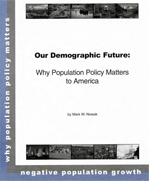Our Demographic Future: Why Population Policy Matters to America
- Mark Nowak
- January 16, 1998
- Special Report
- 0 Comments

This intriguing piece takes a look at the beginnings of America’s concern with overpopulation, and our lack of a national population policy today. The first section describes the unfortunate abandonment of congressional support for changes deemed necessary by the Rockefeller Commission 25 years ago including President Nixon’s dismissing of the Commission’s recommendations even though the Commission had concluded that “no substantial benefits would result from continued growth of the nation’s population.”
The second half of the piece asks, “Would life be better now had the Commission’s recommendations been adopted? And will life be worse in the future because we dismissed the Commission’s goals?” The conclusion outlines a plan for America to gradually reduce our vast numbers, and strive for implementation of the policies that for decades have been recognized as vital to our country’s future.
| Although the United States is generally thought of as a leader in social policy, when it comes to demographic policy the U.S. is well behind much of the rest of the world. In 1993, for example, each of 116 countries – about 60% of all nations – had developed and implemented a population policy of some kind. Rather than leave their demographic futures to chance, these countries are following the recommendations developed at numerous international conferences to work |
actively with international agencies, non-governmental organizations and their own citizens to produce desirable demographic futures. The United States – a signatory to most population documents encouraging the creation of national population policies – is one of the few countries that supports the creation of population policies in principle, but currently is making no effort to develop its own such policy.
Why is this so? The simple answer is that most policy makers in the United States consider explicit demographic decision-making anathema to the democratic process. “It is not up to the government to tell people how many children they can have,” reason these legislators. “Childbearing is a deeply personal matter that should be left entirely to the individuals involved.”
The irony here is that by refusing to engage in demographic decision making, policy makers do not escape the task of setting demographic policy – they merely give up the opportunity to set explicitpolicy. Policy makers still make implicit demographic decisions everyday – some with enormous consequences – the majority of which occur without the slightest demographic scrutiny.
Consider that during a typical session Congress might make laws or establish initiatives on family planning and birth control, sex education, teen pregnancy, reproductive rights, immigration, housing, welfare, marriage and taxation. Collectively these issues have a measurable impact on both the childbearing decisions of Americans as well as the demographic trajectory of the nation. But, since few of the policies are explicitly designed to effect a demographic change (one exception would be the recent changes in welfare law intended to reduce out-of-wedlock childbearing), our political system continues to behave as if demographic decisions can be made, should be made, and are made exclusively by individuals without any influence from government policy.
- Our Demographic Future: Why Population Policy Matters to America - January 16, 1998
- IMMIGRATION AND U.S. POPULATION GROWTH AN ENVIRONMENTAL PERSPECTIVE - September 1, 1997
- Immigration and U.S. Population Growth:An Environmental Perspective - January 16, 1997
